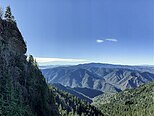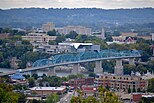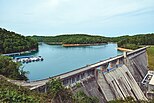East Tennessee
East Tennessee is one of the three Grand Divisions of Tennessee. It is geographically and culturally distinct and comprises approximately the eastern third of the U.S. state of Tennessee. East Tennessee consists of 33 counties. 30 are located within the Eastern Time Zone and three counties in the Central Time Zone which includes Bledsoe, Cumberland, and Marion.[1] East Tennessee is entirely located within the Appalachian Mountains, although the land area range from densely forested 6,000-foot (1,800 m) mountains to broad river valleys. The area has the major cities of Knoxville and Chattanooga which are Tennessee's third and fourth largest cities. It also has the Tri-Cities which is the state's sixth largest population center.
East Tennessee | |
|---|---|
|
Images, from top down, left to right: Clingmans Dome in Great Smoky Mountains National Park the highest point in Tennessee, Neyland Stadium at the University of Tennessee, skyline of Knoxville, skyline of Chattanooga, Norris Dam and its reservoir, Oak Ridge National Laboratory, Sycamore Shoals State Historic Area | |
| Nickname(s): East TN, East Tenn. | |
 The counties of Tennessee highlighted in red are part of East Tennessee. | |
| Country | |
| State | |
| Largest city | Knoxville |
| Area | |
| • Land | 35,115.8 km2 (13,558.27 sq mi) |
| Population (2020) | 2,470,105 |
| • Density | 70.34/km2 (182.18/sq mi) |
| Demonym | East Tennessean |
Tourism
changeThe Great Smoky Mountains National Park which was created in 1934, led to a tourism boom in Sevier and Blount counties, effectively converting the tiny mountain hamlets of Gatlinburg and Pigeon Forge into resort towns. Today, the Great Smoky Mountains National Park is the most visited national park in the United States, receiving more than 14 million visitors annually. The park also anchors a massive tourism industry in nearby Gatlinburg, Pigeon Forge, and Sevierville, which is the third-largest in the state.[2] Some of these attractions Dollywood, the most visited ticketed attraction in Tennessee, Ober Gatlinburg, and Ripley's Aquarium of the Smokies.
The Appalachian Trail, one of the world's most known hiking trails which was was built in the mid-1930s and passes along the Tennessee-North Carolina border. Attractions in Chattanooga include the Tennessee Aquarium, the nation's largest freshwater aquarium. Knoxville hosted the 1982 World's Fair, which drew over 11 million visitors, making it one of the most popular world's fairs in history. The Sunsphere was built for this.
Colleges
changeThe area's major public universities are the University of Tennessee and East Tennessee State University in Johnson City. Private four-year institutions include Bryan College, Carson–Newman University, King University, Lee University, Lincoln Memorial University, Maryville College, Milligan College, Johnson University, Tennessee Wesleyan University, and Tusculum University. Several public community colleges and vocational/technical schools also are located in the region, such as Northeast State Community College in Blountville, Walters State Community College in Morristown, Pellissippi State Community College near Knoxville, Chattanooga State Community College, and Cleveland State Community College. The Tennessee College of Applied Technology has several campuses across the area.
The "Volunteers", or "Vols", are the region's most popular sports teams, and are a multimillion-dollar industry.[3] The university's football team plays at Neyland Stadium, one of the nation's largest stadiums.[4] Nearby is Thompson–Boling Arena. It has broken several attendance records for college men's and women's basketball.[5]
Counties
change| Rank | County | Pop. | |||||||
|---|---|---|---|---|---|---|---|---|---|
| Knoxville Chattanooga |
1 | Knoxville | Knox | 190,740 | Johnson City Kingsport | ||||
| 2 | Chattanooga | Hamilton | 181,099 | ||||||
| 3 | Johnson City | Washington | 71,046 | ||||||
| 4 | Kingsport | Sullivan | 55,442 | ||||||
| 5 | Cleveland | Bradley | 47,356 | ||||||
| 6 | Maryville | Blount | 31,907 | ||||||
| 7 | Oak Ridge | Anderson | 31,402 | ||||||
| 8 | Morristown | Hamblen | 30,431 | ||||||
| 9 | Bristol | Sullivan | 27,147 | ||||||
| 10 | Farragut | Knox | 23,506 | ||||||
References
change- ↑ "Tennessee Blue Book 2015-2016" (PDF). sos.tn.gov. Nashville: Tennessee Secretary of State. 2015. p. 639. Retrieved June 5, 2021.
- ↑ 2019 Economic Impact of Travel on Tennessee (PDF) (Report). Tennessee Department of Tourist Development. August 2020. Retrieved 2021-04-18.
- ↑ John Majors and Ann Toplovich, College Football. Tennessee Encyclopedia of History and Culture, 2002. Retrieved: August 18, 2009.
- ↑ Neyland Stadium Archived September 19, 2012, at Archive.today. UTsports.com, 2009. Retrieved: August 18, 2009.
- ↑ Thompson-Boling Assembly Center & Arena Archived February 5, 2013, at Archive.today. UTsports.com, 2009. Retrieved: August 18, 2009.
- ↑ "City and Town Population Totals: 2010-2019". United States Census Bureau, Population Division. Retrieved May 21, 2020.






